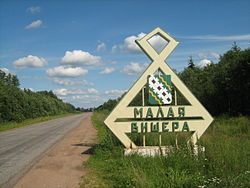Malaya Vishera
| Malaya Vishera (in English) Малая Вишера (Russian) |
|
|---|---|
| - Town - | |
 Welcome sign at the entrance to Malaya Vishera |
|
 Location of Novgorod Oblast in Russia |
|
|
|
|
|
|
|
|
|
|
| Administrative status (as of April 2014) | |
| Country | Russia |
| Federal subject | Novgorod Oblast |
| Administrative district | Malovishersky District |
| Town of district significance | Malaya Vishera |
| Administrative center of | Malovishersky District, town of district significance of Malaya Vishera |
| Municipal status (as of September 2010) | |
| Municipal district | Malovishersky Municipal District |
| Urban settlement | Malovisherskoye Urban Settlement |
| Administrative center of | Malovishersky Municipal District, Malovisherskoye Urban Settlement |
| Statistics | |
| Population (2010 Census) | 12,461 inhabitants |
| Time zone | MSK (UTC+03:00) |
| Founded | 1843 |
| Town status since | 1921 |
| Postal code(s) | 174260, 174262 |
| on | |
Malaya Vishera (Russian: Ма́лая Ви́шера) is a town and the administrative center of Malovishersky District in Novgorod Oblast, Russia. Population: 12,461 (2010 Census);14,182 (2002 Census);15,647 (1989 Census).
The name of the town originates from the Malaya Vishera River, a tributary of the Vishera River. It was founded in 1843, as the construction of the Moscow–St. Petersburg Railway (opened in 1851) passing through the modern town started. At the time, it was a part of Krestetsky Uyezd of Novgorod Governorate. On February 24, 1918, Malovishersky Uyezd was established and Malaya Vishera became its seat. In 1921, Malaya Vishera was granted town status.
In August 1927, the uyezds were abolished and, effective October 1, 1927, Malovishersky District was established, with the administrative center in Malaya Vishera. Novgorod Governorate was abolished as well and the district became a part of Novgorod Okrug of Leningrad Oblast. On July 23, 1930, the okrugs were abolished and the districts were directly subordinated to the oblast.
During World War II, between October 23 and December 22, 1941, Malaya Vishera was occupied by German troops. It became the eighth Soviet town liberated by Soviet troops in 1941 and the first one among those which were not subsequently re-occupied.
...
Wikipedia


